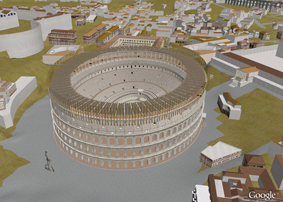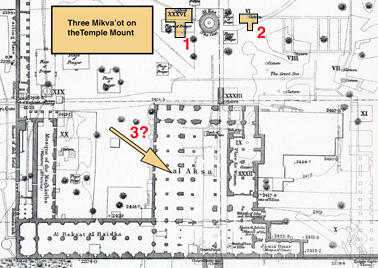During the month of March, anyone can access the ESV Study Bible for free at this website:
http://www.esvstudybible.org/online
It was a privilege to have worked on this wonderful project. This is what Justin Taylor (Project Director) wrote:
“The ESVSB was published just over four months ago and there are already 300,000 copies in print. We give God the honor and the praise, and we pray that God would use this resource to help edify and build up his church.”
Category: News
Ivory pomegranate found in City of David excavations
Joseph Lauer passed on this interesting information:
“Dr. Eliot Braun noted on the ANE-2 list that the January 9, 2009 Ha’aretz Hebrew online edition has an illustrated report about the discovery in the City of David excavations led by Dr. Ronny Reich and Eli Shukron of a miniature ivory pomegranate and a bulla (among over 170 other bullae found in the excavations).
The article, which has not yet appeared in Ha’aretz English online edition, may be read here.
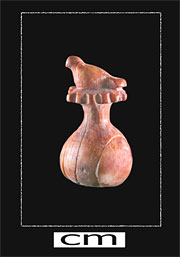
picture of the pomegranate
Also on the ANE-2 list, Dr. Victor Avigdor Hurowitz has taken issue with certain statements made in the article, including “that the pomegranate found in the City of David is similar in form to the 400 decorative pomegranates which are described in Solomon’s Temple according to the book of I Kings 7:43 (should be v. 42 and cf also v, 20!)”. Calling this “absolute nonsense”, he points out that “The pomegranates in the temple descriptions were part of the Yakhin and Boaz pillar crowns which were made of bronze and not ivory as is the new pomegranate.” With regard to the dove sitting on the pomegranate, he writes that I Kings 7 “doesn’t describe the pomegranates at all, let alone the doves on top of them, unless we somehow take hassebakah mentioned along with weharimmonim as a corruption of hassobek (dove coop).” He concludes that “At most one can say that the newly discovered pomegranate can be, like pomegranates mentioned in various biblical passages, a decorative motif known also from cultic contexts.” See here.
Additional ANE-2 postings have been made. I’m sure that many more articles and postings will follow.”
The Temple Mount and the National Geographic
In May this year, I was asked to join the National Geographic team on a poster supplement for the December Issue of the magazine. The subject of the poster was the history and architecture of the Temple Mount. I had the opportunity to meet with Fernando Baptista and Patricia Healy (NGS Senior Graphics Editor and Art Researcher respectively) in New York during a conference on “The Temple of Jerusalem: From Moses to Messiah”. See my earlier post.
They wanted my help with the creation of a NG poster on the Temple Mount and also came to see the models I had designed and which were then on show in the Yeshiva University. This interesting poster is now available in the December issue. The poster is called “Jerusalem’s Holy Ground” and shows, from top to bottom, the Binding of Isaac, The Rock, Solomon’s Temple, Herod’s Temple Mount and the Temple Mount during the Early Muslim period. It also shows cut-away drawings of Solomon’s Temple, Herod’s Temple and the Dome of the Rock and has a timeline on the side. The other side of the poster shows a magnificent map of the Eastern Mediterranean region, named “The Crucible of History”. The poster is beautifully produced and it is worthwhile getting the National Geographic December issue if you don’t have a subscription. The magazine has for its main theme, The Real King Herod, architect of the Holy Land.
Here is a view of the poster, reproduced with permission of the National Geographic Society:
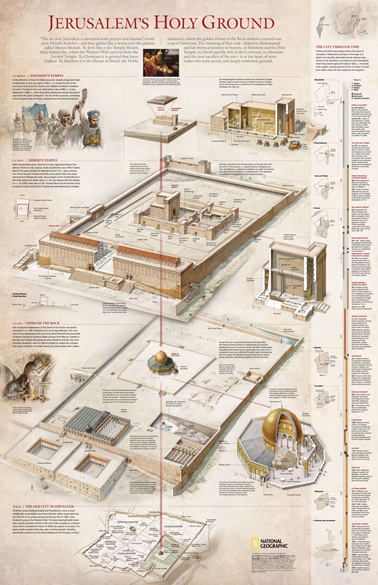
Temple Mount Mikveh
Zachi Zweig, an archaeologist who is involved with the Temple Mount Sifting project, kindly send me the paper [in Hebrew], which he gave at the recent conference on the Temple Mount at the Bar-Ilan University. I commented on this find in an earlier post. Here is an abstract:
“Hamilton describes the discovery of a plastered cistern that was excavated below the easternmost door of the present El Aksa mosque, north of Cistern 9 [according to Warren’s numeration – see map]. The descent to [the cistern] was from west to east by means of a flight of steps, with the bottom step some 3 m. [10 feet] below the present floor of the mosque. The remains of some five steps were discerned, which were built against a plastered wall, which was about 90 cm wide [3 feet].
Unfortunately, Hamilton did not publish additional details – not one picture or plan. However, in the Mandatory Archives there was a photograph of the five steps, which descend to the opening of the cistern. The top of the steps is located some 1.50 – 2 m. [6-7.5 feet] below the present surface and to the south of it and adjacent to it, although at a little distance, there is a thick wall. This is most likely the same cistern. The steps appear to have been cut out of the rock and this points to the fact that the level of the top of the rock in this location is at about 1.50 m. [6 feet] below the level of the present pavement.”
The exit of the cistern is located deep below the level of the floor of the mosque. Hamilton dated it to the late Roman period. However, as the remains of a dividing wall can be discerned, Zachi concluded that it could have been a mikveh (Jewish ritual bath), see picture below:

It is located a little to the east of the underground passage which leads up from the Double Gate to the Temple Mount. Ronnie Reich has identified Cistern 6 and 36 as mikva’ot, but these are located in the original Square Temple Mount. These could have been added in the Second Temple period, as they are located close to the surface and no First Temple period mikva’ot are known.
This latest one, however, is located much lower down and in the Hasmonean extension of the Temple Mount and may therefore have been one of the earliest mikva’ot in Jerusalem:
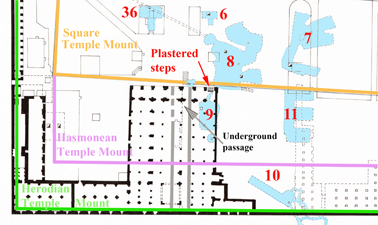 Worshipers in the Hasmonean period, who had not purified themselves before going to the Temple Mount, perhaps had the opportunity to do so in this mikveh, if it was a mikveh indeed.
Worshipers in the Hasmonean period, who had not purified themselves before going to the Temple Mount, perhaps had the opportunity to do so in this mikveh, if it was a mikveh indeed.
Jerusalem and Rome
Third Jewish Mikveh and a Byzantine Mosaic floor discovered on the Temple Mount
It was reported in the Jerusalem Post that during the recent Rennert/Bar-Ilan University’s conference on “New Studies on Jerusalem”, Zachi Zweig pointed out that during reconstruction work at the El-Aqsa mosque in the 1930’s, the remains of a Byzantine mosaic floor and a mikveh (Jewish ritual bath) were discovered. The mikveh was located below the Byzantine floor.
This is an important discovery and will change our views on the history of the Temple Mount. The mosaic floor may or may not have belonged to a church. More information is necessary before deductions can be made about the nature of the building, but the mosaic pattern possibly indicates a public building.
The mikveh would be the third we know of on the Temple Mount, as two other ones have been identified previously by Ronnie Reich. He based his proposal on the shape of the shape of Cisterns 6 and 36 (1 and 2 on Warren’s map of the Temple Mount below). The exact location of the newly published mikveh (3) inside the El-Aqsa mosque is not yet known. However, this nevertheless proves the Jewish origin of the Temple Mount.
Source: Joe Lauer
Son of the High Priest
Just before Yom Kippur, the Jewish Day of Atonement, a fragment of a stone cover of a sarcophagus has been found with the fragmentary Hebrew inscription: “Son of the High Priest”. It could not have been timed better, for in another 3 days, on October 9th, it will be Yom Kippur, the only day in the year that the High Priest could enter the Holy of Holies. You can read about it on the Israel Antiquities Authority website, from where you can download images of the inscription and the excavation site.
The High Priest used to wear ornate garments, but not on Yom Kippur when he entered the Holy of Holies, for then he only wore linen garments. Here is a picture showing the High Priest in his official garments from our book “The Ritual of the Temple in the Time of Christ”.
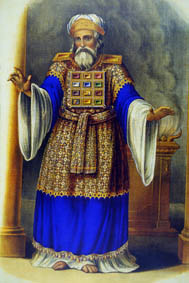
The Temple Mount is Jewish
Arutz-7 has this interesting report on a guide to the Temple Mount, published by the Supreme Moslim Council in 1925. On page 4, it states this about the historical importance of the Temple Mount: “Its identity with the site of Solomon’s Temple is beyond dispute. This, too, is the spot, according to universal belief, on which “David built there an altar unto the Lord, and offered burnt offerings and peace offerings”. (2 Sam. 24.25).
A facsimile of the 16-page booklet can be downloaded from the Temple Institute website.
So, all the recent Palestinian hype about the Temple Denial (meaning that there never stood a Jewish Temple on the Temple Mount) holds no water, but is political posturing only.
As long as Muslims and rabbis (see previous post) ignore archaeological evidence, there will be no end to political and religious arguments.
The Gamla Synagogue
The ESV Study Bible has now started a blog and today an interesting post was put up about the Gamla Synagogue. When I first started to work for the ESV Study Bible, I was shown a beautiful reconstruction painting of this synagogue which had a red tiled roof. The artist did not know that roof tiles were only introduced to the Land of Israel in the Roman period and were much used in the Byzantine period. Most of the roofs of churches and synagogues at that time had pitched roofs, covered with tiles.
Not so, however, during the Herodian period, when the Gamla Synagogue was built. Some tiles may have been imported for large public buildings, but most of the roofs were flat, especially in the Golan where wood is scarce. In 1973, just after the Yom Kippur War, I was asked to accompany a group of IDF archaeologists, who were doing a survey in the territory that had been newly captured from Syria. It was here that I was first introduced to buildings made of basalt blocks. Not only the walls, but the door and window frames were all made of basalt stones and the roof was made of long basalt slabs, which rested on corbels which projected from the walls.
I was quite sure that the Gamla Synagogue had a similar flat roof and that is what it shown in the drawing below (used by permission). As an interesting aside and as mentioned in a previous blog, this type of roof construction would explain how the paralytic man could have been let down through the “tiling” (Luke 5.19) in order to be healed by Jesus. It is more than likely that the roof of the house in Capernaum, where the houses were also made of basalt, was made of long basalt slabs laid at a short distance from each other and which were then covered with flat basalt tiles. After removing these tiles and taking away the basalt cross beams, a space would have been created large enough to let a man down through.
A similar flat roof construction would have been used in the Gamla Synagogue. It has been a privilege to have worked with the ESV Study Bible and Maltings Partnership and the painting below is the result of our joint endeavors:
The Temple Mount gates
Tonight, Friday the 1st of August, is also the beginning of the Hebrew month Ab. On the 9th of this month the Jews remember the destruction of the two temples that stood on Mount Moriah, but tonight, they march around the gates of the Temple Mount to express their desire is to build a new Temple.
The ceremony is called “Sivuv She’arim” – going round the gates – and this is the seventh year that they have marched round the gates of the Temple Mount. You can read the Jerusalem Post report here.
The founder of Sivuv She’arim, Rabbi Tzvi Rogin, used to visit our home, when we lived in Yorkshire, and we had many animated discussions about the Temple Mount. Our family once participated in this ceremony and it was an exhilarating experience.
For those of you who don’t know all the Temple Mount gates, here is a drawing showing their location:

The original names of the gates of the Herodian Temple Mount walls are not known. They possibly never had names.
Today we refer to the gates in the Western Wall (from north to south) as Warren’s Gate, Wilson’s Arch (which was part of a bridge and led to a gate which was built into the western portico), Barclay’s Gate and Robinson’s Arch – which supported a stairway leading to a gate, which was also built into the western portico. Warren, Wilson, Barclay and Robinson were explorers, who worked in Jerusalem in the late 1800’s.
There are two Herodian gates in the Southern Wall, the Double Gate and the Triple Gate. These gates are sometimes erroneously called the Huldah Gates, for these were located on the Temple Mount and were not part of the Herodian retaining walls.
There were two gates in the Eastern Wall, a small gate near the south-east corner, which led into what is now called the Solomon’s Stables and the main eastern gate, which was located where the Golden Gate now stands. Inside this gate are two monolithic gate posts which belonged to the earlier Shushan Gate.
There may have been another Herodian gate in the northern wall, but no remains have been found and it is only once mentioned by Josephus.
The earlier square Temple Mount, which was originally constructed by King Hezekiah, had five gates and their names are known. In the west was the Coponius Gate, the two gates in the southern wall were called the Huldah Gates. We have already mentioned the Shushan Gate in the eastern wall and the gate in the northern wall was called the Tadi Gate. This gate may have been buried underground by the Herodian expansion to the north.

